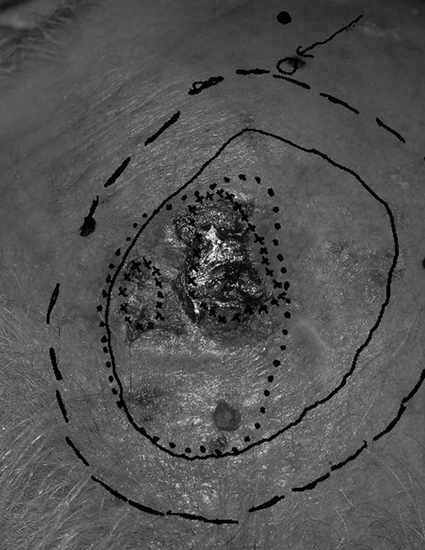
Article
Use of Protoporphyrin Fluorescence to Determine Clinical Target Volume for Non-melanotic Skin Cancers Treated with Primary Radiotherapy
Cureus
(2016)
Abstract
Purpose
Non-melanotic skin cancers remain the most commonly diagnosed cancers. Radiotherapy and surgery are the most common treatment options. Radiotherapy has a recurrence rate of up to 20% for basal or squamous cell cancers. One of the difficulties is to determine the extent of disease for poorly demarcated tumors. This study utilizes protoporphyrin (PpIX) fluorescence to provide information on the extent of subclinical disease for poorly demarcated tumors treated with radiotherapy.
Materials and Methods
For 33 patients, PpIX photo-delineation was used to determine the clinical target volume (CTV2), which was compared to current conventional margins used to account for microscopic disease.
Results
The use of PpIX photo-delineation demonstrated a significantly larger CTV of 15 mm compared to the conventional 10 mm (p = 0.03) for poorly demarcated lesions. A larger CTV was also demonstrated with PpIX photo-delineation for all basal cell carcinomas (13 mm, p = 0.03) as well as for non-nasal lesions (14 mm, p = 0.04). A trend towards an increased CTV was also noted for squamous cell carcinomas (16 mm, p = 0.19) and nasal primary sites (14 mm, p = 0.11). Nasal primary malignancies had multifocal PpIX uptake in 94% of cases. There was one case of local recurrence and one case of distant recurrence, with an average follow-up time of 22 months.
Conclusions
The margins currently used to account for subclinical disease may underestimate the extent of microscopic spread for poorly demarcated tumors. Longer follow-up with larger pools of patients are necessary to determine if using PpIX photo-delineation translates into significantly improved clinical outcomes.
Keywords
- photo-delineation,
- ala (δ-aminolevulinic acid),
- mal (methyl-5-aminolevulinate),
- protoporphyrin-9 (pp-ix),
- ctv (clinical target volume),
- radiotherapy,
- scc (squamous cell cancer),
- bcc (basal cell cancer),
- poorly defined skin cancer
Disciplines
Publication Date
Summer September 4, 2016
DOI
doi:10.7759
Citation Information
Stephanie Casey, Lara Best, Olga Vujovic, Kevin Jordan, et al.. "Use of Protoporphyrin Fluorescence to Determine Clinical Target Volume for Non-melanotic Skin Cancers Treated with Primary Radiotherapy" Cureus Vol. 8 Iss. 9 (2016) p. e767 Available at: http://works.bepress.com/edward_yu/193/
